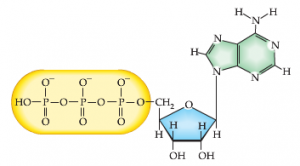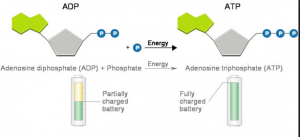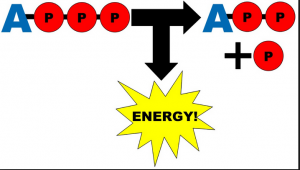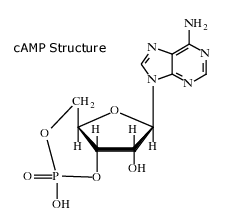Functions of Nucleic Acids
Nucleotide Function
Nucleotides serve a variety of functions in biological systems, including:
- Building blocks for Nucleic Acids (like DNA), which carry genetic information
- Energy Transport within the cell
- Message Carriers between cells
Building Blocks for Nucleic Acids
In the animation below, you will learn how 2 separate long chains of deoxynucleotides form the complete DNA molecule. Please note the unique pairing properties of the different types of nucleotides present on opposite strands of the DNA molecule; (A) always pairs with (T) and (C) always pairs with (G). This is the secret why DNA is such a powerful and reliable molecule used to store genetic information since the sequence of nucleotides present on one chain will inform/determine the sequence of nucleotides on the opposite chain.
From: http://www.dnalc.org/resources/3d/07-how-dna-is-packaged-basic.html
Energy Transport
Nucleotides can also be used in biological systems to carry energy. A prime example of this is the molecule ATP or ‘Adenosine TriPhosphate’. The Phosphate Functional Group found in all nucleotides contains an electrical charge. Note in the diagram below how each of the Oxygen (O) atoms found above each Phosphate (P) atom is noted with a (–) indicating a negative electrical charge.

Due to the strong electrical repulsion that occurs between adjacent Phosphate Functional Groups (because negative charges will repel other negative charges), significant energy is required to add the 3rd and final Phosphate group to the end of this molecule.

The energy required to attach the third Phosphate group becomes ‘trapped’ and stored within the chemical bond holding this group in place. In essence, the ATP molecule is like a tiny ‘battery’ which becomes fully charged when all three Phosphate groups are attached:

ATP is transported throughout the cell and utilized wherever energy is required, such as during the breakdown of larger macromoleucles. The energy stored in the chemical bond between the 2nd and 3rd Phosphate Groups can be released and becomes available to power enzymes to drive chemical reactions.
Messaging
Certain nucleotides, such as cAMP (Cyclic Adenosine MonoPhosphate), are used by the cell to signal the effects of the presence of certain hormones. In the diagram at right, you can see how the single Phosphate group in the lowerleft-handd corner of the molecule forms a ‘loop’ to join back to the 5-Carbon ribose sugar. It is the presence of this ‘loop’ which makes cAMP ‘cyclical’…

In certain cases, the production of cAMP in response to the presence of a hormone can subsequently trigger other chemical reactions within the cell.
Summary
In this activity, you have learned that nucleotides serve the following functions
- Carry and store genetic information
- Energy Transport
- Messaging